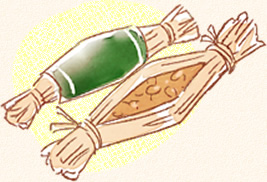
The "Ancient Fortuitousness" TheoryNatto is a uniquely Japanese taste from ancient times. The birth of natto can be linked back to traditions – which date back even as far as the Yayoi Period – of boiling vegetables. At that time, people's dwellings used rugs of woven straw. At some point, some cooked soybeans were dropped onto one of these rugs and over the course of the day, were eventually transformed into natto. The person who lived there, intrigued by the smell coming from the now-fermented beans, tried eating some of them and was pleasantly surprised by his discovery. This led to more being produced, wrapped, and eventually being spread throughout the population.
The "Prince Shotoku" TheoryIt was the era of Prince Shotoku. One day, the prince was feeding soybeans to his favorite horse and found himself with a small amount left over afterwards. The prince thought it a waste to merely throw them out, so he wrapped the beans in straw and set them aside. After a few days had passed, the prince opened the straw wrapping and was shocked at what he found – the cooked beans had become covered in something like string. "That's quite odd," the prince thought, however when he tasted the beans he was shocked yet again; somehow the beans had become even more delicious. The prince was quick to tell as many people as possible of his new discovery, and thus this method of wrapping cooked beans in straw became natto.
The "Minamoto-no-Yoshiie" TheoryIt was the Heian Period and the great military commander Minamoto-no-Yoshiie was on campaign in the modern-day Akita Prefecture. The war was dragging on for longer than had been expected and supplies were beginning to run thin, so Minamoto asked the local farmers to deliver any food they could to his starving troops. The locals hurried to fulfill his request and Minamoto commanded that the large quantities of soybeans which had recently been harvested be boiled, wrapped in straw, and distributed among his men without even being given time to cool. After several days, a strong smell began emanating from the warehouse wherein were stored the wrapped beans. Minamoto found this very odd and when he went to investigate, opening one of the straw bundles, he found the beans seemingly covered in string. When he put some in his mouth, though, he found the taste to be quite palatable. When he passed the fermented beans out among his men, they too were surprisingly pleased by the flavor. This discovery was also passed along to the locals who had originally given the beans to his soldiers, and thus this new food "natto" was spread along with tales of the general Minamoto.It should be noted as well that there are multiple legends regarding Minamoto-no-Yoshiie as the creator of natto, and these tales often disagree as to the location and other details. For example, the story of Ibaraki Prefecture's "Mito Natto" has Minamoto on campaign in near modern Hitachi. This tale states that Minamoto had the beans stored in straw wrapping and carried on his horse, noticed some odd discoloration one day, and upon tasting the beans, found them surprisingly appealing.
The "Emperor Kougon" TheoryIt was the Nanbokucho Period and the emperor Kougon had been forced to abdicate and become a monk, training in the Tabayama Mountain temple – effectively forced into exile, forced out of the splendor of the capital and into life as a penniless hermit. However, there were people who felt sorry for the former emperor and took pity on him, giving him a small bundle of cooked soybeans and miso wrapped in straw. The amount given to him was too much to even eat at one time, and the people's generosity moved the former emperor to tears. He ate a little of the beans every day, until one day, he noticed that they had suddenly become covered with a string-like substance. "Ah," he thought dejectedly, "now I've let them all spoil." However, not wishing to let the overwhelming kindness of the locals go to waste, he decided to eat some of them anyway and was surprised to find them not only still edible, but also quite good. When word eventually reached the townspeople of this, they were very curious and began to make the stringed soybeans for themselves, and thus natto was born.
The "Kato Kiyomasa" Theory It was the time of the reign of Toyotomi Hideyoshi and one of his generals, Kato Kiyomasa, was deployed in Korea along with his army and, far from home, had run into issues keeping them fed. One day, himself hungry from having barely eaten, Kato noticed a strangely appealing smell coming from somewhere near his horse. It appeared to be coming from his pack, carried on the horse's back. When he opened the pack, he found some soybeans with something looking like string stretching between them. As he was starving, even spoiled food was better than nothing, and yet when he ate the beans, he was amazed at their pleasing taste. Eventually, word of this food made its way back to Hideyoshi, who spread it around Japan as well.
Each of these stories is no doubt a jumble of both truth and fiction, so…what are we to do with them? The most important factor appears to be the one that all the stories do share – the fact of the wrapped straw bundle. That said, there are no small amount of facts, studies, and opinions that seek to discredit each of these hypotheses. For example, regarding the first story of some ancient coincidence, there is the scientific argument that the temperature inside a normal home would have been too low for the beans to ferment properly in those conditions. In addition, since there is no written record of natto appearing prior to the Nara Period, it is even more unlikely the origins of natto are indeed ancient.
On the other hand, with regard to the Kato Kiyomasa hypothesis, doubt can be cast upon it for a similar reason. In this case, the fact is that there are records dating from the Muromachi Period showing the existence of natto, therefore the majority of historians believe that any legend of Kato being the originator of natto is just that – a myth.
On a somewhat different topic, there are records from the kitchens of a Heian Period temple referring to a processed soybean food known as nassho, which is thought to be the most likely origin of at least the name of "natto," however beyond that, it does little to shed light on the truth of natto's creation. The ultimate truth of the creation of natto may well be lost to the mists of time.

When it comes to natto, people either love it or hate it; there is almost never a middle ground. Despite its image as a classic part of Japanese breakfasts, there are still large numbers of people who claim that they are incapable of eating it. It is certainly not unfair to say that there are few dishes that are this divisive. For example, there are people who dislike miso soup, however no one, however strong their distaste for it may be, would ever use being forced to eat miso soup as reason for, for example, breaking off a relationship. And yet when it comes to natto, on the internet one can find no shortage of people claiming – perhaps partially in jest – that being made to eat natto would be where they draw the line with another person.
Also notable, foreigners who come to Japan almost always find that they are unable to stomach natto, most often because, perhaps more so than any other dish, natto has a very strong character to its taste and smell. That being said, for many it is this very character that draws them to it, as proved by the legions of natto enthusiasts that can be found, strongly promoting their vision of "Natto Life." In addition, many celebrities, such as authors Arashiyama Kozaburo, Shiina Makoto, and others, have spoken of their own opinions on the benefits of natto, saying that it is immensely helpful to their artful use of language.
On the other hand, it is difficult to find someone willing to take their dislike of natto as far as "Death Before Natto." In general, for those who dislike natto, even intensely, they want to simply have nothing to do with it, rather than being explicitly against it. Then there are also those who form their opinions without truly understanding what it is they dislike. Rather than actually trying it, they just prefer not to know and to ignore it.
People who love it are from Kanto, people who hate it are from Kansai?
When it comes to someone liking or disliking natto, a lot of it also seems to come down to location. When it comes to those who love natto, they seem to have their greatest concentration in Eastern Japan, particularly around Tokyo, whereas those who despise it tend to congregate in Western Japan, especially the regions around Osaka. So the greatest indicator of opinion seems to be a person's home. The taste? The smell? Natto's unique sticky, stringy texture? While these may be factors for some, in the end what it usually boils down to is whether or not a person is familiar with natto and has grown up around it.
◇
It was during the Edo Period that natto well and truly became part of the fabric of Japanese daily life. There was of course plenty of trade that occurred between Edo and Osaka, even in those days, however over time natto still came to be recognized as a distinct flavor of Kanto and the majority of natto sold was sold within Edo. Interestingly, though, following the 1868 Meiji Restoration, natto took on another image as a military ration, being widely distributed among the Japanese military during the Sino-Japanese War, Russo-Japanese War, and both World Wars. This trend began to change, however, during the mid and late 1980s. With the discovery of a compound called Natto Kinaze, natto gained a new image as a health food and began to expand even into regions such as Kansai where it had enjoyed little popularity in the past. Thus natto, during the 80s, finally gained its current national notoriety as a breakfast side dish. That said, it still seems that when it comes to people who admit to loving natto, Kanto continues to far outnumber Kansai.
According to a survey conducted by the Management and Coordination Agency, household purchases of natto remain resolutely high in Eastern Japan and low in the West. When asked how much they spend on natto over the course of one year, the responders with the highest amounts tended to be from the city of Mito in Ibaraki Prefecture, as well as the neighboring Fukushima Prefecture. However this does not account for those households which might make natto themselves at home. That said, it should be noted that immediately behind the prefectures in the Kanto region were those from Tohoku in the Northeast.
On the other hand, the areas with the lowest reported usage of natto are the four prefectures comprising the island of Shikoku, followed by the prefectures of the Kinki region. More specifically, the places with the absolute lowest purchase rates were the city of Osaka itself and the nearby Hyogo Prefecture. These results do certainly seem to prove that Kansai is where those who dislike natto are. It almost seems like the stuff of TV shows – "East VS West," "Lovers VS Haters"…do you think it could work?

Since long ago, the aim has been to sell natto. Recently, the most common method has been to have the natto inside a plastic film or paper package,however this was not always the case. In the past, the natto would be priced by weight using a scale. Hanging on the scales would be something like a colander filled with straw and brimming with fresh natto, accompanied by the seller's cries advertising his wares echoing in Edo's morning air.
However, this natto had to be prepared every night. There were also other shops, though, which sold preserved natto wrapped in straw. Interestingly, these shops were, by decree of the various Lords, located in the same districts as certain other shops such as tofu and pickle sellers, due to the intense smells that accompanied all of their various wares.
Around the time of the Meiji Restoration, some major changes took place in the methods of packaging and selling natto. At this time, doubts began to be expressed about the old method of street peddlers selling out of their colanders. People began questioning the hygiene of such a system. Indeed, natto sold in this method was protected from contamination by, at best, some straw and perhaps a cloth placed over the top, leading to a very real possibility of dirt or dust being mixed in. With the new Meiji Government conforming as much as possible to Western ideas and practices, new standards of sales hygiene were gradually advocated for not only by politicians and state officials, but eventually by the common people as well. Suddenly, the straw that had served as the base packaging for natto going back as far as the Edo Period and beyond was no longer sufficient, thus natto began using the current straw bundles that we see even today, patterned after the Mito style.
From the old days of the hanging colander, natto packaging had evolved to the straw bundle. The next upgrade occurred during the Taisho Period. This time the changes were to the manufacturing operations and facilities themselves, designed to eliminate old contamination hazards such as dirt floors. At this time the straw bundles were largely replaced by paper and wooden boxes, so as to better protect the natto inside. In addition, after 1975, the manufacturing process itself became automated. This final move into mechanization also ushered in the familiar plastic film-covered packages we see nowadays.
Over time, the way natto is packaged and sold has changed dramatically, however when it comes to the "true natto" image, one cannot beat the old style straw packaging, which survives even into the present day, allowing people to add the flavor of nostalgia as almost another "ingredient." This old tradition is still carried on by one particular variant, it is of course, Mito Natto. Although at one time these straw bundles were banned for being primitive and unhygienic, with the modern resolution of their hygiene issues, there are no problems selling them in the current marketplace. Recently this taste of "real" natto has once again been finding an audience among people who wish to experience authentic food.
However, there is also of course no small amount of clever marketing from the "Mito style" manufacturers. When it initially became popular, there were many attempts by companies to capitalize on this newfound enthusiasm, and thus many products entered the market claiming to be Mito Natto when in fact they were produced elsewhere – selling modern varieties disguised in old-fashioned packaging. Naturally, there was a strong amount of backlash when this trend was discovered by the public. However they did not attempt to corner or run down the suppliers who falsified their products, rather the whole experience only strengthened the image that "real natto" can only come from Mito. Therefore the impersonating products, unable to match the taste of the genuine article, were gradually weeded out from the market. Beyond that, a number of companies, desperate to earn back sales, actually moved their production to Mito and by doing so managed to become genuine themselves. Thus the common image now when one speaks of natto is that of Mito Natto in its signature straw bundled package. Therefore the victory was ultimately won by the original manufacturers of Mito, who, embodying their natto itself, clung stickily to their product and finally prevailed by never compromising their integrity.

















